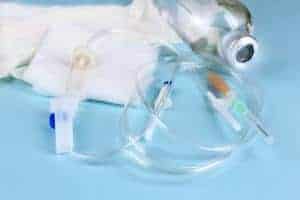Medical teams yesterday described their experience treating two sick US health workers with TKM-Ebola and convalescent serum, while another group that looked at genetic sequences from Liberian Ebola patient reported that changes in the virus so far don’t appear to affect diagnosis and experimental treatments.
Investigators published their findings in Clinical Infectious Diseases and Emerging Infectious Diseases, respectively.
First use of experimental combo
The first study involved two US physicians who were evacuated from the outbreak region after they were infected with Ebola. Rick Sacra, MD, was flown to the high-biocontainment unit at Nebraska Medical Center in Sep 5 after he was infected in Liberia, and Ian Crozier, MD, was admitted to Emory University Hospital’s special communicable disease unit on Sep 9 after he was infected in Sierra Leone.
Sacra is a family medicine physician from the University of Massachusetts Medical School who was working for the missionary group SIM USA, and Crozier is an infectious disease specialist from Vanderbilt University who was working for the World Health Organization (WHO).
Both patients received aggressive supportive care, and their clinicians got clearance and patient consent to use two experimental treatments: TKM-Ebola, a short-strand RNA (siRNA) drug cocktail developed by Tekmira Pharmaceuticals, and convalescent serum.
Sacra received his first of seven daily TKM-Ebola infusions on day 8 of his illness. He experienced fever and chills after his first three treatments with the drug and chills on the final day. He received 1 liter of type-specific convalescent plasma from a recovered patient in two 500-milliliter (mL) transfusions on days 9 and 10 of his illness with no sign of transfusion reaction.
He recovered and was discharged from the hospital on day 28 of his illness.
Crozier was given his first TKM-Ebola infusion on day 3 of his illness before his medical evacuation, and he continued to receive it after he was admitted to Emory. His medical team discontinued the medication after the fifth dose, however, because clinicians worried that it might have been contributing to his deteriorating medical condition, which included worsening acidosis, atrial fibrillation, and kidney problems.
He received six 500-mL doses of convalescent plasma on days 8, 9, 11, 12, 14, and 15 of his illness. Crozier’s shortness of breath worsened after his first transfusion, and he needed oxygen, which required intubation. His condition slowly improved, and he was extubated on day 21.
After recovery, he was discharged from Emory on day 44 of his illness.
Unclear if treatments helped
Clinicians who treated both patients said it’s unknown if uncontrolled use of experimental treatments helped the two survivors, and they noted that aggressive supportive care probably contributed to their recovery. They linked Crozier’s deteriorating condition to his Ebola infection, but said it’s impossible to exclude the role of the experimental treatments.
They noted that clinical studies so far haven’t shown any serious adverse effects and that the fever and chills Sacra experienced aren’t unexpected with siRNA treatment. They said, though, that future studies on siRNA products should explore the possibility of adverse effects from immune activation.
Also unclear is whether Ebola immunoglobulins or other plasma components in convalescent serum played any role in the recovery of the two doctors, the team wrote, emphasizing that controlled trials are needed to gauge the effects on the clinical course of the disease.
A trial of TKM-Ebola launched in March in Sierra Leone, and trials of convalescent plasma therapy are also under way in the outbreak countries.
Real-time Ebola sequencing in Liberia
The gene-sequencing study was conducted with advanced capabilities provided by a consortium by the US government and nongovernmental agencies to help Liberia’s government with Ebola surveillance. The group has equipped the Liberian Institute for Biomedical Research with a Miseq sequencer.
The team of US and Liberian researchers described their analysis of 25 genomes from samples collected from September 2014 through February 2015.
They noted that the findings suggest a single introduction of the virus into Liberia, but a comparison with other isolates from the region showed a relationship to Ebola virus from Mali, hinting at movement of the virus across Liberia’s border at least once.
Though viruses showed diversification in Liberia, researchers found nothing unusual with the pace of the virus changes.
The group found 23 nonsynonymous mutations and 1 nonsense mutation that haven’t been seen before in West Africa, but they said more study is needed to determine if they affect viral fitness. Five of the mutations they found might affect a component of ZMapp binding, but the changes were seen at low levels, they reported. The team didn’t find any changes that would impair the diagnostic tests that Liberia uses for Ebola.
Case total update, test kit recall
- The WHO said today that the number of confirmed, probable, and suspected Ebola infections in the three affected countries has edged up to 26,074, with the number of deaths reaching 10,820. The totals reflect an increase of 30 cases and 12 deaths since the WHO’s update yesterday. Today’s numbers include data from Guinea and Sierra Leone as of Apr 21 and Liberia as of Apr 19.
- The US Food and Drug Administration (FDA) today announced that LuSys Laboratories, based in San Diego, has recalled its Ebola Virus One-Step Test Kits, because they are not cleared for marketing. It said the devices were sold in California and exported to Sierra Leone, Canada, and Denmark between October 2014 and January 2015. It said the devices don’t have emergency use authorization clearance. The agency said the tests haven’t been cleared for use or sale and that results obtained from the kits haven’t shown to be accurate. False-positives or false-negatives could be life threatening, the FDA said. LuSys initiated a product recall on Mar 13.

